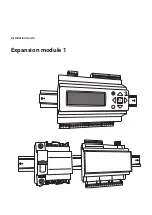
10
3.5 FLUE TERMINAL LOCATION - Figs. 4 and 5
Alpha InTec S - General Boiler Information
A Directly below an opening, air brick, windows, etc.
B Below gutters, soil pipes or drain pipes
C Below eaves
D Below balconies
E From a vertical drain pipe or soil pipe
F From an internal or external corner
G Above ground, roof or balcony level
H From a surface or boundary facing the terminal
I
From a terminal facing the terminal
J Above an opening, air brick, window etc.
K Vertically from a terminal on the same wall
L Horizontally from a terminal on the same wall
M Horizontally from an opening, air brick, window etc.
N Minimum protrusion through a roof
O From a vertical obstruction
P From an openable window
Q From an adjacent vertical terminal
Min. distance (mm)
Terminal position
300
(See Note 1)
75
(See Note 3)
200
(See Note 3)
200
(See Note 3)
150
(See Note 3)
300
(See Note 2)
300
600
(See Note 4)
1200 mm
300
(See Note 1)
1500 mm
300 mm
300 mm
(See Note 1)
300 mm
300 mm
600 mm
600 mm
J
D
G
H I
Q
Boundary
O P
N
Fig. 4
Notes:
1. In addition, the terminal should not be nearer than 150 mm to the framework of an opening into the building, i.e. a
window surround or door surround.
2. This clearance may be reduced to 25 mm without effecting the performance of the boiler. However, to ensure the
condensate plume does not affect adjacent surfaces a clearance of 300 mm is preferable.
3. These clearances may be reduced to 25 mm without effecting the performance of the boiler. However, to ensure the
condensate plume does not affect adjacent surfaces the terminal can be extended beyond gutters, pipes, eaves,
balconies etc. by upto 500 mm. If the flue is xtended more than 500 mm outside, it should be boxed and insulated.
4. To reduce the possibility of nuisance to neighbouring buildings etc. it is recommended the terminal should not be less
than 2500 mm from car parking spaces, building boundary walls, fences etc.
5. A terminal must not be sited under a car port roof.
6. In certain weather conditions the terminal will emit a plume of steam. If possible avoid positioning the terminal where
this may cause a nuisance, i.e. positions A, D, G, H, J or M.
7.
The
fl
ue terminal must be exposed to the external air and the position must allow the free passage of air across it at all times.
8. A terminal must not be sited below 2 m where people have access to, such as public footpaths, access routes, patios
etc. However, If the terminal is fitted less than 2 m ab ve a surface where there is no public access, the terminal must
be protected by a terminal guard. A suitable guard is available from Alpha Therm Ltd.











































